
|
Now it is 9.1 mag (Apr. 9, Marco Goiato). Fading slowly. In the Northern Hemisphere, it is not observable now, but it will appear in August. It locates somewhat low in the Southern Hemisphere. But it will become high in summer.
Date(TT) R.A. (2000) Decl. Delta r Elong. m1 Best Time(A, h)
Apr. 22 4 25.64 -29 5.0 2.804 2.367 54 9.0 20:08 ( 64,-13)
Apr. 29 4 37.57 -26 15.8 2.908 2.422 52 9.2 20:16 ( 69,-16)
|

|
Now it is 10.0 mag (Apr. 9, Thomas Lehmann). It stays 10 mag for a while. Now it is not observable. It will appear in June.
Date(TT) R.A. (2000) Decl. Delta r Elong. m1 Best Time(A, h)
Apr. 22 2 27.11 27 52.5 3.174 2.236 17 10.0 20:08 (127, -2)
Apr. 29 2 32.49 26 37.2 3.202 2.231 12 10.0 20:16 (131, -8)
|

|
Now it is 12.5 mag (Apr. 2, iTelescope Observatory, Siding Spring). It stays 11 mag for a while. In the Northern Hemisphere, it is not observable now. In the Southern Hemisphere, it stays observable in good condition. It was expected to brighten up to 10 mag from spring to summer. However, it is fainter than expected recently.
Date(TT) R.A. (2000) Decl. Delta r Elong. m1 Best Time(A, h)
Apr. 22 20 32.42 -52 19.7 2.839 3.078 94 10.6 3:49 (336, -4)
Apr. 29 20 39.86 -55 27.0 2.747 3.075 99 10.5 3:39 (339, -6)
|
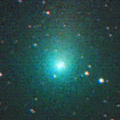
|
Now it is 11.0 mag (Apr. 19, Osamu Miyazaki). Fading gradually. In the Northern Hemisphere, it will be getting higher gradually. In the Southern Hemisphere, it is not observable now, but it will appear in May.
Date(TT) R.A. (2000) Decl. Delta r Elong. m1 Best Time(A, h)
Apr. 22 0 21.03 40 41.7 2.641 1.916 35 11.2 3:49 (231, 17)
Apr. 29 0 29.29 39 52.0 2.682 1.955 35 11.4 3:39 (233, 18)
|
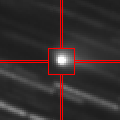
|
Now it is 13.1 mag (Apr. 19, Hirohisa Sato). It stays 11 mag for a while. It stays observable in good condition. It was expected to brighten up to 11 mag from spring to summer. However, it is fainter than expected recently.
Date(TT) R.A. (2000) Decl. Delta r Elong. m1 Best Time(A, h)
Apr. 22 19 24.99 -17 5.1 1.544 1.995 100 11.4 3:49 (332, 33)
Apr. 29 19 34.26 -15 35.1 1.473 1.991 105 11.3 3:39 (333, 35)
|
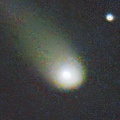
|
Now it is 11.9 mag (Apr. 20, Osamu Miyazaki). Fading slowly. In the Northern Hemisphere, it will be getting lower gradually after this, and it will be unobservable in July. In the Southern Hemisphere, it stays observable in good condition.
Date(TT) R.A. (2000) Decl. Delta r Elong. m1 Best Time(A, h)
Apr. 22 11 9.91 -2 31.8 2.824 3.630 137 11.5 21:09 ( 0, 52)
Apr. 29 10 58.96 -2 51.6 2.922 3.634 128 11.6 20:30 ( 0, 52)
|
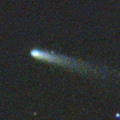
|
Now it is 11.9 mag (Apr. 12, Michael Jager). It will fade out rapidly after this. It will be fainter than 18 mag in July. In the Northern Hemisphere, it will be unobservable in May. But it will be observable again in June. In the Southern Hemisphere, it will be getting higher gradually.
Date(TT) R.A. (2000) Decl. Delta r Elong. m1 Best Time(A, h)
Apr. 22 22 57.87 -1 25.2 0.204 0.877 46 11.5 3:49 (278, 10)
Apr. 29 23 38.17 -6 20.1 0.277 0.838 45 11.6 3:39 (279, 2)
|

|
It approached to Earth down to 0.29 a.u. in early February, and it brightened up to 4.5 mag (Feb. 1, Juan Jose Gonzalez). Now it is 11.9 mag (Apr. 13, Osamu Miyazaki). It will fade out rapidly after this. In the Northern Hemisphere, it will be unobservable soon. It locates somewhat low in the Southern Hemisphere. But it will become high in summer.
Date(TT) R.A. (2000) Decl. Delta r Elong. m1 Best Time(A, h)
Apr. 22 5 7.42 -10 26.8 2.325 1.888 52 11.6 20:08 ( 73, 6)
Apr. 29 5 12.92 -11 17.2 2.471 1.967 49 11.9 20:16 ( 76, 0)
|

|
Now it is 12.8 mag (Apr. 13, Thomas Lehmann). Fading gradually. It stays observable in good condition.
Date(TT) R.A. (2000) Decl. Delta r Elong. m1 Best Time(A, h)
Apr. 22 17 51.57 -18 32.9 1.275 2.010 123 12.5 3:49 (359, 36)
Apr. 29 17 51.62 -18 26.0 1.250 2.047 129 12.6 3:27 ( 0, 37)
|

|
It is expected to brighten up to 8 mag in July. Now it is 14.9 mag (Apr. 19, B. Lutkenhoner, N. Paul, E. Cortes). It will brighten rapidly after this. In the Northern Hemisphere, it is not observable now, but it will appear in June. In the Southern Hemisphere, it will be getting higher gradually. At the high light, it will be observable in excellent condition in the Southern Hemisphere, but it will be very low in the Northern Hemisphere.
Date(TT) R.A. (2000) Decl. Delta r Elong. m1 Best Time(A, h)
Apr. 22 0 37.49 -10 46.7 2.830 2.024 30 12.8 3:49 (272,-16)
Apr. 29 0 39.52 -10 53.8 2.688 1.963 35 12.6 3:39 (274,-13)
|

|
It brightened up to 8.3 mag in last winter (Jan. 6, 2022, Toshiyuki Takahashi). Now it is 12.3 mag (Apr. 19, Chris Wyatt). Fading slowly. In the Northern Hemisphere, it will be unobservable in June. In the Southern Hemisphere, it stays observable in good condition.
Date(TT) R.A. (2000) Decl. Delta r Elong. m1 Best Time(A, h)
Apr. 22 9 2.06 -32 13.2 4.985 5.413 110 12.6 20:08 ( 15, 21)
Apr. 29 9 3.03 -31 45.3 5.095 5.456 105 12.7 20:16 ( 22, 19)
|

|
Rob Matson discovered it as a new comet from SWAN images between Apr. 5 and 15. It was revealed to be an asteroid which has been observed also in 2012 and 2018. It approached to Sun down to 0.5 a.u. on Mar. 29. Now it is 13.6 mag (Apr. 20, Michael Jager). It will fade out rapidly after this. It will be fainter than 18 mag in July. In the Northern Hemisphere, it is not observable now, but it will appear in June. In the Southern Hemisphere, it will be getting higher gradually.
Date(TT) R.A. (2000) Decl. Delta r Elong. m1 Best Time(A, h)
Apr. 22 3 14.49 -25 30.4 0.511 0.712 41 13.1 20:08 ( 75,-25)
Apr. 29 3 15.95 -36 15.7 0.459 0.810 52 13.4 20:16 ( 67,-36)
|
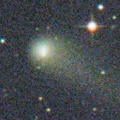
|
It brightened up to 11.1 mag in early 2022 (Mar. 31, 2022, F. Kugel, J.-G. Bosch, J. Nicolas). Now it is 13.2 mag (Apr. 19, Chris Wyatt). Fading slowly. It stays observable in good condition.
Date(TT) R.A. (2000) Decl. Delta r Elong. m1 Best Time(A, h)
Apr. 22 15 37.90 16 42.9 4.147 4.977 141 13.1 1:41 ( 0, 72)
Apr. 29 15 35.09 17 48.5 4.162 5.006 143 13.1 1:10 ( 0, 73)
|
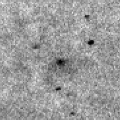
|
Now it is 13.4 mag (Apr. 7, Giuseppe Pappa). Fading slowly. In the Northern Hemisphere, it will be unobservable soon. But it will be observable again in April. In the Southern Hemisphere, it stays observable in good condition.
Date(TT) R.A. (2000) Decl. Delta r Elong. m1 Best Time(A, h)
Apr. 22 23 7.83 -13 26.9 2.288 1.795 48 13.5 3:49 (287, 0)
Apr. 29 23 23.26 -12 7.1 2.269 1.825 51 13.6 3:39 (286, 1)
|

|
Now it is 13.7 mag (Apr. 19, W. Pei). It stays 14 mag for a while. It will be unobservable in June. But it will be observable again in August in the Northern Hemisphere.
Date(TT) R.A. (2000) Decl. Delta r Elong. m1 Best Time(A, h)
Apr. 22 6 31.33 27 16.0 6.436 6.092 65 13.9 20:08 ( 96, 44)
Apr. 29 6 35.31 27 5.6 6.538 6.094 59 14.0 20:16 (100, 37)
|
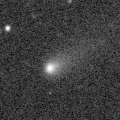
|
Now it is 14.6 mag (Apr. 19, Chris Wyatt). Fading slowly. It locates somewhat low in the Northern Hemisphere. In the Southern Hemisphere, it stays observable in good condition.
Date(TT) R.A. (2000) Decl. Delta r Elong. m1 Best Time(A, h)
Apr. 22 14 3.45 -29 23.2 1.374 2.352 162 14.0 0:07 ( 0, 26)
Apr. 29 13 54.67 -30 16.1 1.375 2.355 162 14.0 23:26 ( 0, 25)
|

|
The brightness evolution is slower than originally predicted. Now it is 14.7 mag (Apr. 9, ATLAS Chile). It stays 14 mag for a while. In the Northern Hemisphere, it is not observable now. It locates somewhat low in the Southern Hemisphere. But it will become high in winter.
Date(TT) R.A. (2000) Decl. Delta r Elong. m1 Best Time(A, h)
Apr. 22 4 27.36 -22 53.5 2.517 2.035 50 14.0 20:08 ( 68, -9)
Apr. 29 4 39.66 -23 59.2 2.515 2.033 50 14.0 20:16 ( 70,-14)
|
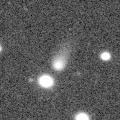
|
It is expected to brighten up to 7 mag in early 2024. Now it is 14.1 mag (Apr. 19, ATLAS South Africa). Brightening gradually. In the Northern Hemisphere, it will be unobservable soon. In the Southern Hemisphere, it will be getting lower gradually. But it will be getting higher again after July.
Date(TT) R.A. (2000) Decl. Delta r Elong. m1 Best Time(A, h)
Apr. 22 5 35.44 -27 18.8 4.312 4.009 65 14.2 20:08 ( 56, 1)
Apr. 29 5 41.52 -26 33.8 4.290 3.939 63 14.1 20:16 ( 60, -4)
|
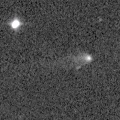
|
Now it is 14.9 mag (Mar. 19, Masayoshi Yoshimi). It stays 14 mag for a while. Now it is not observable. It will appear in May in the Southern Hemisphere, or in June in the Northern Hemisphere.
Date(TT) R.A. (2000) Decl. Delta r Elong. m1 Best Time(A, h)
Apr. 22 2 36.49 -1 35.7 4.201 3.251 16 14.7 20:08 (102,-19)
Apr. 29 2 37.70 -0 41.1 4.205 3.245 15 14.7 20:16 (109,-26)
|
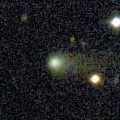
|
Now it is 14.8 mag (Apr. 19, W. Pei). Fading slowly. In the Northern Hemisphere, it stays observable in good condition. It locates somewhat low in the Southern Hemisphere. But it will become high in winter.
Date(TT) R.A. (2000) Decl. Delta r Elong. m1 Best Time(A, h)
Apr. 22 9 32.71 29 7.2 3.047 3.436 104 15.0 20:08 ( 53, 80)
Apr. 29 9 37.52 28 49.5 3.149 3.449 98 15.1 20:16 ( 70, 75)
|

|
It will brighten rapidly up to 13.5 mag in summer. Now it is 17.1 mag (Apr. 8, B. Lutkenhoner, N. Paul, E. Cortes). Brightening slowly. In the Northern Hemisphere, it is not observable now, but it will appear in June. In the Southern Hemisphere, it will be getting higher gradually.
Date(TT) R.A. (2000) Decl. Delta r Elong. m1 Best Time(A, h)
Apr. 22 23 57.43 -24 56.5 2.428 1.891 46 15.3 3:49 (290,-16)
Apr. 29 0 10.55 -22 6.8 2.364 1.860 48 15.1 3:39 (288,-14)
|

|
Now it is 15.4 mag (Apr. 14, Catalina Sky Survey). It stays 15 mag for a while. It will be getting lower gradually after this, and it will be unobservable in June in the Northern Hemisphere, or in July in the Southern Hemisphere. It is expected to brighten up to 12 mag from 2024 to 2025.
Date(TT) R.A. (2000) Decl. Delta r Elong. m1 Best Time(A, h)
Apr. 22 8 59.88 -6 29.7 5.341 5.712 106 15.3 20:08 ( 25, 45)
Apr. 29 8 57.64 -5 24.6 5.412 5.670 99 15.3 20:16 ( 37, 42)
|
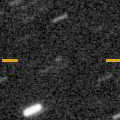
|
Now it is 16.8 mag (Apr. 19, ATLAS South Africa). It stays 15 mag for a while. It stays observable in good condition.
Date(TT) R.A. (2000) Decl. Delta r Elong. m1 Best Time(A, h)
Apr. 22 18 31.65 -16 9.2 2.465 3.010 113 15.4 3:49 (346, 38)
Apr. 29 18 34.09 -16 41.9 2.368 2.997 119 15.3 3:39 (351, 38)
|
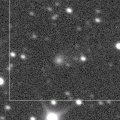
|
It will brighten up to 14 mag from 2024 to 2025. Now it is 15.0 mag (Apr. 10, Yukihiro Sugiyama). It stays 15 mag for a while. In the Northern Hemisphere, it will be unobservable in June. In the Southern Hemisphere, it stays observable in good condition.
Date(TT) R.A. (2000) Decl. Delta r Elong. m1 Best Time(A, h)
Apr. 22 8 46.11 -33 4.2 5.913 6.277 106 15.3 20:08 ( 18, 19)
Apr. 29 8 48.08 -32 16.4 5.946 6.246 102 15.3 20:16 ( 25, 17)
|
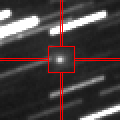
|
Brightened rapidly. Now it is 15.0 mag (Apr. 17, Ken-ichi Kadota). It will fade out rapidly after this. It will be fainter than 18 mag in July. In the Northern Hemisphere, it will be getting higher gradually. In the Southern Hemisphere, it stays observable in good condition.
Date(TT) R.A. (2000) Decl. Delta r Elong. m1 Best Time(A, h)
Apr. 22 12 17.62 -28 34.3 0.881 1.828 151 15.4 22:18 ( 0, 27)
Apr. 29 12 24.91 -23 2.1 0.912 1.857 150 15.5 21:57 ( 0, 32)
|

|
It brightened up to 13.4 mag in last summer (July 7, Giuseppe Pappa). Now it is 15.2 mag (Apr. 19, J. Jahn, D. Husar, W. Pasche). Fading slowly. In the Northern Hemisphere, it stays observable in good condition.
Date(TT) R.A. (2000) Decl. Delta r Elong. m1 Best Time(A, h)
Apr. 22 17 44.24 19 23.6 3.095 3.647 115 15.4 3:47 ( 0, 74)
Apr. 29 17 35.58 21 57.3 3.071 3.686 120 15.4 3:11 ( 0, 77)
|

|
Now it is 16.4 mag (Apr. 28, B. Lutkenhoner, N. Paul, E. Cortes). It stays 15 mag for a while. In the Northern Hemisphere, it is not observable now, but it will appear in May. In the Southern Hemisphere, it will be getting higher gradually.
Date(TT) R.A. (2000) Decl. Delta r Elong. m1 Best Time(A, h)
Apr. 22 23 33.75 -10 36.4 4.020 3.342 42 15.5 3:49 (281, -3)
Apr. 29 23 42.11 -9 49.2 3.966 3.355 46 15.5 3:39 (281, -1)
|
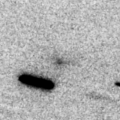
|
Now it is 15.0 mag (Apr. 11, B. Lutkenhoner, N. Paul, E. Cortes). It will fade out rapidly after this. It will be fainter than 18 mag in May. In the Northern Hemisphere, it will never be observable after this. It stays extremely low in the Southern Hemisphere.
Date(TT) R.A. (2000) Decl. Delta r Elong. m1 Best Time(A, h)
Apr. 22 0 27.86 0 13.5 1.647 0.849 24 15.5 3:49 (264, -8)
Apr. 29 0 58.76 3 15.8 1.704 0.877 23 15.9 3:39 (260, -9)
|

|
Now it is 15.9 mag (Apr. 16, ATLAS Chile). It stays 15 mag for a while. It stays observable in good condition. It is expected to brighten up to 12.5 mag in 2024 spring. At the high light, it will be observable in excellent condition in the Southern Hemisphere, but it will be low in the Northern Hemisphere.
Date(TT) R.A. (2000) Decl. Delta r Elong. m1 Best Time(A, h)
Apr. 22 18 19.87 20 38.9 3.808 4.222 107 15.6 3:49 (331, 74)
Apr. 29 18 12.84 21 20.4 3.669 4.172 113 15.5 3:39 (352, 76)
|
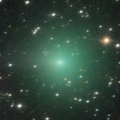
|
It brightened up to 9.7 mag in autumn (Oct. 23, Marco Goiato). Now it is 16.6 mag (Apr. 17, iTelescope Observatory, Siding Spring). It will fade out rapidly after this. It will be fainter than 18 mag in June. It locates somewhat low in the Northern Hemisphere. In the Southern Hemisphere, it stays observable in good condition.
Date(TT) R.A. (2000) Decl. Delta r Elong. m1 Best Time(A, h)
Apr. 22 16 57.17 -45 15.1 1.635 2.401 129 15.5 3:01 ( 0, 10)
Apr. 29 16 20.25 -44 16.7 1.596 2.461 140 15.7 1:57 ( 0, 11)
|
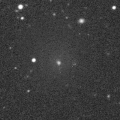
|
It will brighten up to 13 mag from June to August. Now it is 15.9 mag (Apr. 16, Ken-ichi Kadota). Brightening gradually. In the Northern Hemisphere, it stays observable in good condition. In the Southern Hemisphere, it will be unobservable in May. But it will be observable again in August.
Date(TT) R.A. (2000) Decl. Delta r Elong. m1 Best Time(A, h)
Apr. 22 12 23.76 48 20.6 0.769 1.512 116 15.7 22:23 (180, 76)
Apr. 29 12 17.82 53 3.6 0.766 1.437 107 15.5 21:49 (180, 72)
|
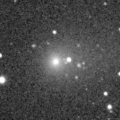
|
It brightened up to 12.4 mag in winter (Feb. 10, Taras Prystavski). Now it is 14.8 mag (Apr. 19, W. Pei). It will fade out rapidly after this. It will be fainter than 18 mag in July. It stays observable in good condition.
Date(TT) R.A. (2000) Decl. Delta r Elong. m1 Best Time(A, h)
Apr. 22 9 5.38 20 35.6 1.769 2.201 101 15.6 20:08 ( 47, 70)
Apr. 29 9 14.78 20 13.2 1.874 2.231 96 15.8 20:16 ( 58, 66)
|

|
It will brighten up to 13 mag in summer. Now it is 16.3 mag (Apr. 9, Ken-ichi Kadota). Brightening gradually. In the Northern Hemisphere, it will be getting higher gradually. In the Southern Hemisphere, it is not observable now, but it will appear in August.
Date(TT) R.A. (2000) Decl. Delta r Elong. m1 Best Time(A, h)
Apr. 22 2 11.14 64 18.8 2.061 1.653 52 15.8 20:08 (156, 20)
Apr. 29 2 9.00 63 42.8 2.061 1.603 49 15.6 3:39 (203, 19)
|

|
It continued brightening even after the perihelion passage. Now it is 16.6 mag (Apr. 9, Yukihiro Sugiyama). Fading slowly. It will be fainter than 18 mag in July. In the Northern Hemisphere, it will be getting lower gradually after this, and it will be unobservable in July. It locates somewhat low in the Southern Hemisphere.
Date(TT) R.A. (2000) Decl. Delta r Elong. m1 Best Time(A, h)
Apr. 22 8 0.39 24 51.3 2.764 2.872 85 16.3 20:08 ( 78, 61)
Apr. 29 8 8.32 24 30.1 2.880 2.897 80 16.4 20:16 ( 83, 55)
|

|
It brightened up to 9.6 mag in late January (Jan. 25, Toshihiko Ikemura, Hirohisa Sato). Now it is 14.5 mag (Apr. 12, Thomas Lehmann). Fading rapidly. It will be fainter than 18 mag in May. It locates somewhat low in the Northern Hemisphere. In the Southern Hemisphere, it stays observable in good condition.
Date(TT) R.A. (2000) Decl. Delta r Elong. m1 Best Time(A, h)
Apr. 22 7 27.48 -7 19.7 1.742 1.925 84 16.3 20:08 ( 50, 33)
Apr. 29 7 38.64 -8 45.6 1.875 1.994 81 16.9 20:16 ( 54, 28)
|

|
Now it is 16.5 mag (Apr. 10, Michael Jager). It stays 16 mag for a while. In the Northern Hemisphere, it will be getting lower gradually after this, and it will be unobservable in June. In the Southern Hemisphere, it stays observable in good condition.
Date(TT) R.A. (2000) Decl. Delta r Elong. m1 Best Time(A, h)
Apr. 22 8 22.28 -8 20.3 3.700 3.966 97 16.3 20:08 ( 35, 40)
Apr. 29 8 20.29 -8 39.3 3.788 3.944 91 16.4 20:16 ( 45, 35)
|

|
It has not been observed yet in this apparition. It will brighten up to 11 mag in July. Brightening rapidly. It stays extremely low in the Northern Hemisphere. But it will become high in autumn. It locates somewhat low in the Southern Hemisphere.
Date(TT) R.A. (2000) Decl. Delta r Elong. m1 Best Time(A, h)
Apr. 22 22 44.52 3 21.7 1.930 1.468 48 16.9 3:49 (276, 15)
Apr. 29 23 7.76 5 38.9 1.843 1.401 48 16.4 3:39 (274, 15)
|
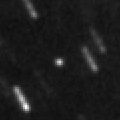
|
It will approach to Sun down to 0.4 a.u. in late September in 2024, and it is expected to brighten up to 0 mag. Now it is 16.4 mag (Apr. 20, Yukihiro Sugiyama). It stays 16 mag for a while. It stays observable in good condition. At the high light, in the Northern Hemisphere, it will be observable in good condition after the perihelion passage. In the Southern Hemisphere, it will be observable in the low sky before and after the perihelion passage.
Date(TT) R.A. (2000) Decl. Delta r Elong. m1 Best Time(A, h)
Apr. 22 14 57.91 1 43.0 5.840 6.790 159 16.7 1:01 ( 0, 57)
Apr. 29 14 52.97 2 4.9 5.762 6.727 162 16.6 0:29 ( 0, 57)
|

|
Now it is 17.2 mag (Apr. 7, ATLAS-HKO, Haleakala). Fading slowly. It will be fainter than 18 mag in August. In the Northern Hemisphere, it will be getting lower gradually. It locates somewhat low in the Southern Hemisphere.
Date(TT) R.A. (2000) Decl. Delta r Elong. m1 Best Time(A, h)
Apr. 22 8 43.14 25 36.7 1.911 2.236 95 16.6 20:08 ( 68, 70)
Apr. 29 8 52.17 24 47.4 1.984 2.232 90 16.7 20:16 ( 74, 64)
|
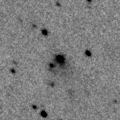
|
It approached to Sun down to 0.1 a.u. on Jan. 31. It was bright as 7.0-7.5 mag in early February (Feb. 5, Michael Jager). Now it is 15.4 mag (Apr. 13, Ken-ichi Kadota). It will fade out rapidly after this. It will be fainter than 18 mag in June. It stays observable in good condition.
Date(TT) R.A. (2000) Decl. Delta r Elong. m1 Best Time(A, h)
Apr. 22 20 11.30 -9 48.1 1.523 1.802 88 16.7 3:49 (316, 34)
Apr. 29 20 4.67 -10 27.2 1.497 1.902 96 16.9 3:39 (322, 36)
|

|
Very far object. Now it is 16.9 mag (Apr. 17, ATLAS South Africa). It stays 17 mag for a while. In the Northern Hemisphere, it is not observable now. In the Southern Hemisphere, it stays observable in good condition.
Date(TT) R.A. (2000) Decl. Delta r Elong. m1 Best Time(A, h)
Apr. 22 4 58.52 -68 59.6 10.377 10.372 86 16.8 20:08 ( 23,-28)
Apr. 29 5 0.67 -68 32.5 10.365 10.369 87 16.8 20:16 ( 25,-31)
|

|
It brightened up to 9.3 mag in early summer in 2022 (June 5, Chris Wyatt). Now it is 16.8 mag (Apr. 17, Masayoshi Yoshimi). Fading gradually. It will be fainter than 18 mag in June. In the Northern Hemisphere, it will be unobservable in May. In the Southern Hemisphere, it will be getting lower gradually.
Date(TT) R.A. (2000) Decl. Delta r Elong. m1 Best Time(A, h)
Apr. 22 6 45.50 -7 1.4 4.206 4.051 74 16.8 20:08 ( 59, 27)
Apr. 29 6 48.12 -5 40.9 4.372 4.114 68 17.0 20:16 ( 66, 21)
|
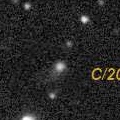
|
Now it is 17.0 mag (Apr. 11, Michael Jager). It stays 17 mag for a while. It stays observable in good condition.
Date(TT) R.A. (2000) Decl. Delta r Elong. m1 Best Time(A, h)
Apr. 22 12 45.17 12 49.2 8.085 8.966 149 16.9 22:44 ( 0, 68)
Apr. 29 12 40.82 13 12.9 8.152 8.974 142 16.9 22:12 ( 0, 68)
|

|
Now it is 17.0 mag (Apr. 15, J. Linder). It stays 17 mag for a while. In the Northern Hemisphere, it stays observable in good condition. In the Southern Hemisphere, it is not observable now, but it will appear in May.
Date(TT) R.A. (2000) Decl. Delta r Elong. m1 Best Time(A, h)
Apr. 22 13 3.87 56 17.7 2.575 3.080 110 16.9 23:03 (180, 69)
Apr. 29 13 1.61 56 25.5 2.602 3.057 107 16.9 22:33 (180, 69)
|

|
It brightened up to 13.6 mag in 2021 (June 17, 2021, R. Carstens). Now it is 17.2 mag (Apr. 17, ATLAS South Africa). It stays 17 mag for a while. In the Northern Hemisphere, it will never be observable after this. In the Southern Hemisphere, it stays observable in good condition.
Date(TT) R.A. (2000) Decl. Delta r Elong. m1 Best Time(A, h)
Apr. 22 12 34.49 -73 29.6 5.888 6.412 117 16.9 22:32 ( 0,-19)
Apr. 29 12 13.82 -72 55.3 5.904 6.443 118 16.9 21:44 ( 0,-18)
|

|
It brightened up to 12.7 mag in last year (Feb. 27, 2022, Jose Guilherme de S. Aguiar). Now it is 17.2 mag (Apr. 11, ATLAS South Africa). Fading slowly. It will be fainter than 18 mag in August. It locates somewhat low in the Northern Hemisphere. In the Southern Hemisphere, it stays observable in good condition.
Date(TT) R.A. (2000) Decl. Delta r Elong. m1 Best Time(A, h)
Apr. 22 19 57.03 -24 37.9 2.591 2.857 94 17.0 3:49 (328, 23)
Apr. 29 20 1.54 -24 35.7 2.522 2.883 100 17.0 3:39 (331, 24)
|
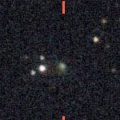
|
It brightened rapidly up to 15.8 mag (Mar. 19, Toshihiko Ikemura, Hirohisa Sato). Now it is 16.4 mag (Apr. 10, Michael Jager). It will fade out rapidly after this. It will be fainter than 18 mag in May. In the Northern Hemisphere, it will be getting lower gradually. It locates somewhat low in the Southern Hemisphere.
Date(TT) R.A. (2000) Decl. Delta r Elong. m1 Best Time(A, h)
Apr. 22 7 16.07 24 14.6 1.856 1.885 76 17.0 20:08 ( 85, 51)
Apr. 29 7 18.56 20 31.5 1.995 1.907 70 17.2 20:16 ( 86, 43)
|

|
Hidetaka Sato detected its cometary activity. Now it is 17.2 mag (Apr. 9, Hidetaka Sato). It stays 17 mag for a while. It stays extremely low in the Northern Hemisphere. But it will become high in autumn. In the Southern Hemisphere, it stays observable in good condition.
Date(TT) R.A. (2000) Decl. Delta r Elong. m1 Best Time(A, h)
Apr. 22 22 8.17 -26 30.7 2.907 2.688 67 17.1 3:49 (305, 3)
Apr. 29 22 20.88 -26 2.6 2.835 2.687 71 17.1 3:39 (306, 4)
|
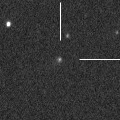
|
Now it is 17.3 mag (Apr. 17, Masayoshi Yoshimi). It stays 18 mag for a while. In the Northern Hemisphere, it stays observable in good condition. It locates somewhat low in the Southern Hemisphere.
Date(TT) R.A. (2000) Decl. Delta r Elong. m1 Best Time(A, h)
Apr. 22 9 20.80 35 14.0 2.186 2.555 99 17.2 20:08 ( 94, 80)
Apr. 29 9 26.83 34 18.2 2.258 2.546 94 17.2 20:16 ( 92, 74)
|
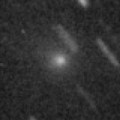
|
It brightened up to 11 mag in SWAN images in January (Jan. 23, Vladimir Bezugly). Now it is 16.3 mag (Apr. 1, iTelescope Observatory, Siding Spring). Fading rapidly. It will be fainter than 18 mag in May. In the Northern Hemisphere, it will never be observable after this. In the Southern Hemisphere, it stays observable in good condition.
Date(TT) R.A. (2000) Decl. Delta r Elong. m1 Best Time(A, h)
Apr. 22 23 40.41 -60 21.0 1.714 1.785 77 17.2 3:49 (325,-29)
Apr. 29 0 24.12 -63 42.3 1.741 1.873 81 17.7 3:39 (328,-33)
|
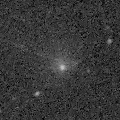
|
Very large comet. It is expected to brighten up to 14 mag in 2031. Now it is 16.7 mag (Apr. 14, Thomas Lehmann). It stays 17 mag for a while. In the Northern Hemisphere, it is not observable now. In the Southern Hemisphere, it will be getting higher gradually. In the Northern Hemisphere, it is not observable until 2030.
Date(TT) R.A. (2000) Decl. Delta r Elong. m1 Best Time(A, h)
Apr. 22 2 50.67 -57 17.0 18.067 17.750 70 17.3 20:08 ( 41,-39)
Apr. 29 2 53.74 -57 15.4 18.015 17.725 71 17.3 20:16 ( 41,-43)
|

|
It returns for the first time in 70 years. It will brighten up to 4.5 mag in 2024 spring. Now it is 17.9 mag (Apr. 3, Ken-ichi Kadota). Brightening gradually. In the Northern Hemisphere, it stays observable in good condition. In the Southern Hemisphere, it will be unobservable in July.
Date(TT) R.A. (2000) Decl. Delta r Elong. m1 Best Time(A, h)
Apr. 22 19 36.07 40 9.0 4.719 4.760 86 17.5 3:49 (248, 68)
Apr. 29 19 36.54 41 46.1 4.603 4.694 88 17.4 3:39 (242, 71)
|
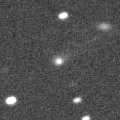
|
It brightened up to 15.9 mag in 2022 spring (May 5, Toshiyuki Takahashi). Now it is 17.2 mag (Apr. 17, ATLAS South Africa). It stays 18 mag for a while. It stays observable in good condition.
Date(TT) R.A. (2000) Decl. Delta r Elong. m1 Best Time(A, h)
Apr. 22 16 27.68 -24 41.5 4.077 4.909 142 17.6 2:31 ( 0, 30)
Apr. 29 16 25.13 -24 41.8 4.023 4.917 149 17.6 2:01 ( 0, 30)
|
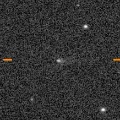
|
Now it is 16.9 mag (Apr. 3, Ken-ichi Kadota). It will fade out rapidly after this. It will be fainter than 18 mag in May. It stays observable in good condition.
Date(TT) R.A. (2000) Decl. Delta r Elong. m1 Best Time(A, h)
Apr. 22 13 21.93 23 28.9 0.622 1.550 143 17.6 23:21 ( 0, 78)
Apr. 29 13 20.23 21 10.7 0.680 1.596 141 17.9 22:52 ( 0, 76)
|

|
Now it is 17.3 mag (Apr. 18, ATLAS-HKO, Haleakala). It stays 18 mag for a while. In the Northern Hemisphere, it stays observable in good condition. In the Southern Hemisphere, it will never be observable after this.
Date(TT) R.A. (2000) Decl. Delta r Elong. m1 Best Time(A, h)
Apr. 22 18 17.05 76 44.0 9.935 9.878 83 17.6 3:49 (182, 48)
Apr. 29 18 8.11 77 34.4 9.970 9.896 82 17.6 3:39 (180, 47)
|
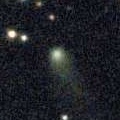
|
Now it is 17.9 mag (Apr. 8, Mt. Lemmon Survey). It stays 18 mag for a while. In the Northern Hemisphere, it stays observable in good condition. In the Southern Hemisphere, it will never be observable after this.
Date(TT) R.A. (2000) Decl. Delta r Elong. m1 Best Time(A, h)
Apr. 22 18 53.95 58 2.7 6.376 6.419 87 17.6 3:49 (200, 64)
Apr. 29 18 54.23 59 11.8 6.398 6.454 88 17.6 3:39 (195, 65)
|

|
Brightening slowly. In the Northern Hemisphere, it will be getting higher gradually. In the Southern Hemisphere, it stays observable in good condition.
Date(TT) R.A. (2000) Decl. Delta r Elong. m1 Best Time(A, h)
Apr. 22 22 4.95 -10 3.9 3.406 3.058 61 17.7 3:49 (293, 14)
Apr. 29 22 13.61 -9 37.1 3.317 3.054 66 17.6 3:39 (295, 16)
|

|
It brightened very rapidly up to 15.5 mag from last autumn to last winter (Nov. 2, 2021, Toshihiko Ikemura, Hirohisa Sato). Now it is 17.4 mag (Apr. 9, Giuseppe Pappa). It stays 18 mag for a while. In the Northern Hemisphere, it will be getting lower gradually. It locates somewhat low in the Southern Hemisphere.
Date(TT) R.A. (2000) Decl. Delta r Elong. m1 Best Time(A, h)
Apr. 22 6 33.50 11 45.9 5.103 4.810 67 17.7 20:08 ( 78, 36)
Apr. 29 6 38.59 11 50.4 5.220 4.832 62 17.7 20:16 ( 83, 30)
|
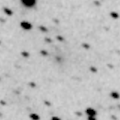
|
Now it is 17.2 mag (Apr. 17, Ken-ichi Kadota). Fading slowly. It will be fainter than 18 mag in May. In the Northern Hemisphere, it will be getting higher gradually. In the Southern Hemisphere, it stays observable in good condition.
Date(TT) R.A. (2000) Decl. Delta r Elong. m1 Best Time(A, h)
Apr. 22 21 39.75 6 8.8 2.346 2.101 63 17.7 3:49 (284, 29)
Apr. 29 21 48.68 8 29.8 2.320 2.143 67 17.8 3:39 (283, 33)
|
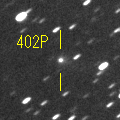
|
It brightened up to 15.3 mag in last winter (Jan. 12, 2022, Hidenori Nohara). Now it is 17.4 mag (Apr. 17, Masayoshi Yoshimi). Fading slowly. It will be fainter than 18 mag in May. In the Northern Hemisphere, it stays observable in good condition. It locates somewhat low in the Southern Hemisphere.
Date(TT) R.A. (2000) Decl. Delta r Elong. m1 Best Time(A, h)
Apr. 22 9 50.91 31 15.2 4.390 4.782 107 17.7 20:08 ( 44, 85)
Apr. 29 9 52.11 31 6.1 4.510 4.802 100 17.8 20:16 ( 73, 79)
|

|
It was regarded as an asteroid, but its cometary activity was detected. Now it is 17.9 mag (Apr. 10, Michael Jager). It will fade out rapidly after this. It will be fainter than 18 mag soon. In the Northern Hemisphere, it will be getting lower gradually. In the Southern Hemisphere, it stays observable in good condition.
Date(TT) R.A. (2000) Decl. Delta r Elong. m1 Best Time(A, h)
Apr. 22 7 2.51 15 38.6 1.447 1.517 73 17.8 20:08 ( 77, 45)
Apr. 29 7 25.21 14 55.4 1.516 1.551 72 18.0 20:16 ( 78, 42)
|

|
It has not been observed yet in this apparition. Now it is mag ( , ). Brightening slowly. It stays observable in good condition.
Date(TT) R.A. (2000) Decl. Delta r Elong. m1 Best Time(A, h)
Apr. 22 18 26.91 -16 36.4 2.432 2.994 114 18.1 3:49 (348, 38)
Apr. 29 18 28.86 -16 1.1 2.326 2.971 120 17.9 3:39 (352, 39)
|

|
It was predicted to brighten up to 16 mag in 2023. But actually, it is very faint as 18.1 mag (Mar. 29, ATLAS Chile). It stays 18 mag for a while. In the Northern Hemisphere, it is not observable now. In the Southern Hemisphere, it stays observable in good condition.
Date(TT) R.A. (2000) Decl. Delta r Elong. m1 Best Time(A, h)
Apr. 22 20 40.41 -75 51.2 3.002 3.310 98 18.0 3:49 (349,-24)
Apr. 29 20 52.80 -76 8.7 2.965 3.324 102 18.0 3:39 (350,-24)
|
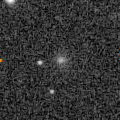
|
It moves along an almost circular orbit. It brightened up to 16.2 mag temporarily in outburst (Jan. 27, Toshihiko Ikemura, Hirohisa Sato). Now it is 17.4 mag (Apr. 10, Michael Jager). Fading slowly. In the Northern Hemisphere, it stays observable in good condition. It locates somewhat low in the Southern Hemisphere.
Date(TT) R.A. (2000) Decl. Delta r Elong. m1 Best Time(A, h)
Apr. 22 10 35.71 25 56.0 5.602 6.141 118 18.1 20:35 ( 0, 81)
Apr. 29 10 35.15 25 42.9 5.697 6.141 111 18.2 20:16 ( 11, 80)
|
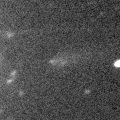
|
Now it is 19.2 mag (Apr. 13, A. Diepvens). Fading slowly. It stays observable in good condition. Francois Kugel reported it seems fragmented.
Date(TT) R.A. (2000) Decl. Delta r Elong. m1 Best Time(A, h)
Apr. 22 10 5.39 16 25.7 3.636 4.178 116 18.6 20:08 ( 2, 71)
Apr. 29 10 6.57 16 18.4 3.730 4.178 109 18.6 20:16 ( 26, 69)
|

|
In its last apparition in 2014, it was re-observed after 36-year blank. It has not been observed yet in this apparition. It will turn to fade out rapidly after brightening. It stays extremely low in the Northern Hemisphere. In the Southern Hemisphere, it will be getting lower gradually after this, and it will be unobservable in July.
Date(TT) R.A. (2000) Decl. Delta r Elong. m1 Best Time(A, h)
Apr. 22 22 55.34 -16 22.0 1.499 1.201 52 20.2 3:49 (291, 1)
Apr. 29 23 27.47 -12 46.1 1.434 1.122 51 19.4 3:39 (286, 0)
|
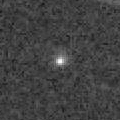
|
It was observed at 17 mag in 2022 autumn. It was predicted to be observable at 17 mag also in 2023 spring. But actually, it is extremely faint as 19.7 mag (Apr. 1, Taras Prystavski). It will fade out rapidly after this. It stays observable in good condition.
Date(TT) R.A. (2000) Decl. Delta r Elong. m1 Best Time(A, h)
Apr. 22 19 33.24 13 49.7 1.615 1.942 92 19.6 3:49 (305, 58)
Apr. 29 19 10.56 16 43.7 1.511 1.990 102 19.6 3:39 (317, 66)
|

|
In the last apparition, it had faded before the perihelion passage. It was expected to brighten up to 17 mag if it would become as bright as its last apparition. But actually, it is extremely faint as 22 mag (Apr. 8, Giuseppe Pappa). It stays 22 mag for a while. It stays observable in good condition.
Date(TT) R.A. (2000) Decl. Delta r Elong. m1 Best Time(A, h)
Apr. 22 14 1.67 6 45.5 1.763 2.734 161 21.6 0:05 ( 0, 62)
Apr. 29 13 57.59 7 11.6 1.764 2.722 157 21.6 23:29 ( 0, 62)
|
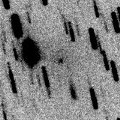
|
Tiny comet, but it approached to Sun down to 0.8 a.u. in January, and it will approach to Earth down to 0.6 a.u. in March. It was expected to brighten up to 14 mag from January to March. But actually, it became disintegrated before the perihelion passage. Now it is extremely faint as 18.2 mag (Feb. 20, Thomas Lehmann). Fading rapidly. In the Northern Hemisphere, it will be getting lower gradually. It locates somewhat low in the Southern Hemisphere.
Date(TT) R.A. (2000) Decl. Delta r Elong. m1 Best Time(A, h)
Apr. 22 8 20.31 20 20.2 1.421 1.759 91 21.8 20:08 ( 65, 62)
Apr. 29 8 33.59 22 42.6 1.609 1.852 86 22.2 20:16 ( 75, 59)
|
|
![]()
 C/2022 E2 ( ATLAS )
C/2022 E2 ( ATLAS ) 199P/Shoemaker 4
199P/Shoemaker 4 C/2021 G2 ( ATLAS )
C/2021 G2 ( ATLAS ) C/2023 B2 ( ATLAS )
C/2023 B2 ( ATLAS ) C/2020 R7 ( ATLAS )
C/2020 R7 ( ATLAS ) 117P/Helin-Roman-Alu 1
117P/Helin-Roman-Alu 1 300P/Catalina
300P/Catalina C/2022 L2 ( ATLAS )
C/2022 L2 ( ATLAS ) C/2022 P1 ( NEOWISE )
C/2022 P1 ( NEOWISE ) C/2023 E1 ( ATLAS )
C/2023 E1 ( ATLAS ) 118P/Shoemaker-Levy 4
118P/Shoemaker-Levy 4 C/2022 W3 ( Leonard )
C/2022 W3 ( Leonard ) 119P/Parker-Hartley
119P/Parker-Hartley C/2022 U2 ( ATLAS )
C/2022 U2 ( ATLAS ) C/2022 A3 ( Lemmon-ATLAS )
C/2022 A3 ( Lemmon-ATLAS ) 185P/Petriew
185P/Petriew C/2023 A3 ( Tsuchinshan-ATLAS )
C/2023 A3 ( Tsuchinshan-ATLAS ) 94P/Russell 4
94P/Russell 4 96P/Machholz 1
96P/Machholz 1 C/2019 E3 ( ATLAS )
C/2019 E3 ( ATLAS ) C/2021 E3 ( ZTF )
C/2021 E3 ( ZTF ) C/2020 F2 ( ATLAS )
C/2020 F2 ( ATLAS ) C/2022 U4 ( Bok )
C/2022 U4 ( Bok ) C/2018 U1 ( Lemmon )
C/2018 U1 ( Lemmon ) 116P/Wild 4
116P/Wild 4 C/2023 A1 ( Leonard )
C/2023 A1 ( Leonard ) 2022 JK5
2022 JK5 180P/NEAT
180P/NEAT C/2023 A2 ( SWAN )
C/2023 A2 ( SWAN ) C/2014 UN271 ( Bernardinelli-Bernstein )
C/2014 UN271 ( Bernardinelli-Bernstein ) 12P/Pons-Brooks
12P/Pons-Brooks 99P/Kowal 1
99P/Kowal 1 263P/Gibbs
263P/Gibbs C/2019 O3 ( Palomar )
C/2019 O3 ( Palomar ) C/2020 H6 ( ATLAS )
C/2020 H6 ( ATLAS ) 287P/Christensen
287P/Christensen P/2021 N2 ( Fuls )
P/2021 N2 ( Fuls ) 80P/Peters-Hartley
80P/Peters-Hartley 402P/2020 Q3 ( LINEAR )
402P/2020 Q3 ( LINEAR ) 459P/Catalina
459P/Catalina 219P/LINEAR
219P/LINEAR C/2021 C5 ( PanSTARRS )
C/2021 C5 ( PanSTARRS ) P/2023 B1 ( PanSTARRS )
P/2023 B1 ( PanSTARRS ) 452P/2022 B5 ( Sheppard-Jewitt )
452P/2022 B5 ( Sheppard-Jewitt ) 72P/Denning-Fujikawa
72P/Denning-Fujikawa C/2022 Q2 ( ATLAS )
C/2022 Q2 ( ATLAS ) 280P/Larsen
280P/Larsen C/2022 S3 ( PanSTARRS )
C/2022 S3 ( PanSTARRS )![]()





























































